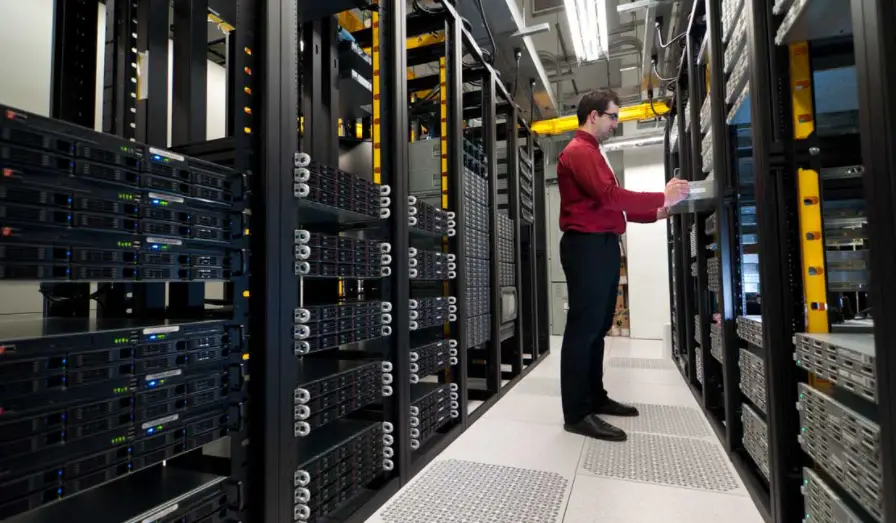Information presented on this web page is intended for informational and educational purposes only and is not meant to be taken as legal, financial, investment or tax advice. We do not accept any responsibility for any trading or investment related losses. Please review our disclaimer on before taking action based upon anything you read or see.
Setting up a server represents a significant investment for a small business. Whether you are purchasing an on-premises solution or moving your business to the cloud, you should do the same due diligence and thorough research before making the purchase. Your current technology provider; can even advise you on where to get the best price and the best service experience. In this guide, I will show you how to build a server system for a small business.
Servers; play an important role in small business infrastructure and protecting sensitive data, which influences the growth of the server market. Thus, learning how to configure an enterprise server is an important first step before making a major purchasing decision.
If you are purchasing all equipment from a single company, find out what they offer. In this sense, you can take your business to the next level. A technical representative should conduct a thorough needs analysis and point you in the right direction toward the server you’ve always wanted.
How to Set Up a Small Business Server System

The exact server procedure for a small or medium-sized company is contingent on the selected hardware and operating system. However, some criteria still have to be followed.
- Document your network before you begin. Write down the user name, IP address, hostname, serial number, and location of each computer. Next, check the server hardware and software requirements. You may need to upgrade the computers’ operating systems on your network to connect to the server. Therefore, you will also need to purchase additional equipment for installation, such as Ethernet cables and external hard drives.
- You can connect the server to the network and start the setup with a pre-installed OS. If not, insert the setup media (DVD, USB, virtual media) and continue the operating system installations instructions. Back up the server as soon as possible after installation (you may need an external hard drive), configure the physical server for remote access, and set up the partition configuration. Finally, configure the server as a domain controller so that all computers on the network can join the new centralized environment and the server can authenticate users.
- Add and connect to the physical server a local admin account for every PC or Mac. Connect printers to the print server and install printers. Organize and download to a new server the requested data and applications such as accounts and checks.
How to Build a Server System for a Small Business

You are considering upgrading your current business to be more efficient. It will include a new server for hosting company files, databases, e-mails, and websites. You have heard about the benefits of cloud computing, but it is expensive at this time, so you decide to build your server system with an operating system to run most of the business processes.
What is it? A small business server can reduce costs by reducing the number of computers needed to run daily business functions such as file serving, e-mail, or web browsing.
They typically include one or two powerful CPUs, multiple storage devices like hard disks and optical drives, redundant power supplies, networking cards (Gigabit network connectivity), a server-class operating system, and a case that meets the needs for cooling, power, and space.
Process of Building a Server System for a Small Business
- Build a server case
- Put the motherboard in the case and attach the power supply to the motherboard.
- Attach hard disks or solid-state drives to a motherboard
- Memory that connects to appropriate slots on the motherboard (laptops use SODIMM)
- IF NECESSARY, add PCI cards (network card, graphics card, sound card, etc.) for your application.
- Power on and install the operating system; configure it for use as a business used servers system.
- Now, configure BIOS settings such as boot order and security features.
- Configure RAID settings if appropriate for your server application.
- Install any other applications required by the business on top of the operating system. For example, install anti-virus software and configure it to update automatically. Windows Server includes anti-virus software that can be activated with a purchase code; you don’t need to separately purchase an antivirus package like McAfee or Symantec Endpoint Protection.
- Network-attached storage (NAS) is not typically recommended. It has limited capacity and functionality compared to a full-fledged server system; however, NAS may make sense for some installations where low power consumption, small size, and affordability are more important than raw processing power or maximum storage capacity.
- Add optional peripherals like USB flash drives or external hard drives.
- Add a monitor, keyboard, and mouse.
Things to Keep in mind
You should now have a fully functional networked business server system! In addition to the benefits described above, you may also save money as there is no need to purchase as many stand-alone computers for daily business functions. In addition to saving money on equipment purchases, your company will benefit from not needing as much IT support staff because the IT load has been distributed over more computers and servers by centralizing computing resources.
If you used cloud computing instead of a small business server, it would be more expensive than buying new equipment for your company’s needs. The cost would likely be too high without adding all sorts of other features that you don’t need, and the downside is a loss of control over your data.
See this post about How to Start a Cloud Computing Business.
How to Set up the Network
To set up a network, you must connect the following components:
- Each network must have at least one server.
- A switch; is a component that connects the network devices and allows them to communicate. You can choose between managed and unmanaged switches, but small businesses usually choose unmanaged switches.
- A router connects different networks, for example connecting an office network to the Internet or creating an internal network.
- If you choose a wired or wireless network, you will need cables. Typically, choose copper or fiber optic: Fiber optic cables are durable and faster for data transfer.
Value the resources that will perform the processes.
- Please do some research on each of them; using calculators from different server companies, you will be able to calculate how many resources are needed to run different programs with your company’s capacity.
- Write down the results and the high and low estimates of what is needed for each project or application. Add them up to get the average capacity you had when you bought the server, and then add 20% for maximum usage.
- You already have the minimum specifications for most of the parts – start with those. You may want to work with a third-party expert to address other requirements such as RAID, hot-swappable disk arrays, processors, power options, and hardware redundancy. Third-party consultants may also uncover new issues you hadn’t considered, such as whether you need a redesigned infrastructure for Internet connectivity.
- Consider in advance the rack servers or blade servers’ room specifications, including windows, backup power, and cooling systems, to ensure the security of your equipment. This step alone can be burdensome for your company, but you should take it before buying equipment.
- Ask questions of the IT team to help them plan the server room configuration. How will you meet racking, cable management, and security needs?
Server System; Importance and Functions
A server is a computer designed to run applications for a single user and provide services that everyone in the enterprise can use. So, these services can be accessed from computers connected to the company’s local network or over the Internet.
A server is a physical device or software with power. Therefore, it allows other computers on the same network to access information, software, services, or storage space. The other computers on the network are called clients, and the server’s job is to balance some of the load for those customers.
Enterprise servers help prioritize resources and can be a more secure way to share and store data than individual computers. In addition, they can be given a name that suits their task, such as “Small Business File Server,” if they are only responsible for maintaining client files.
Servers can be used for a variety of business functions, such as:
- Business applications
- Data storage and backup
- Databases
- E-commerce
- Electronic mail
- Archiving
- Web sites
- Centralize, share and exchange information between employees on-site or remotely.
- Work with business-critical applications such as accounting, financial, or sales software.
- Improve information security. A single server ensures the security of company data and information and automates central backups.
- Sharing printers and other devices is much easier through the network port.
Many small office servers are called dedicated servers because they are designed to perform a single function. For example, an e-mail server works to receive, store and send email data. Another example is an e-commerce server unit that hosts and services your company’s online store.
Frequently Asked Questions
How much does a server cost for a small business?
The average cost of a dedicated server lease for a small business ranges from $110 to $210 per month. You can establish a cloud server for as little as $7 per month. However, most businesses will spend around $45 per month to get enough resources. If you want to buy a server for your office, it can cost $1,100 and $3,100 for a small business.
What does it take to build a server?
To build your server, you only need a few resources:
- Computer can be your personal computer if it has a good ram and hard disk capacity.
- Broadband Internet connection.
- Network router with an Ethernet cable (CAT5).
- Monitor and keyboard.
What does a small business server do?
Small business servers, hardware or software, have a design to handle business tasks; simple and complex. Therefore, you can rely on servers to organize communications, manage databases, host business applications, and much more.
What do I need to build a server?
Server resources are necessary; they are closely related to the types of hardware:
- The hard disk space, the size of the processor, the number of cores, and the clock frequency to a lesser extent.
- The amount of memory (RAM) of the server. A file server has several places on its hard disk because it is mainly used for storage.
- An operating system can be Linux or Windows.
Bottom Line
At this point, we find all the related information that deciphers how to set up a server system for a small business. To use incorrectly form this material; it will allow achieving the raised objectives. In this way, making a technological update within the framework of the operations of your small business will be simple and effective. In addition, you will optimize the processes that frame the production and development of the products and services you offer.
So, you will provide new work tools to your employees, which will help optimize their collective and individual performance. In this way, you will boost and compete in today’s broad and necessary markets. But, on the other hand, you will obtain security in your sensitive information, guarantee smooth work.
The two most important components of the device you require are switches and routers when creating a small office network. Although they appear the same, the two devices function in a network differently.
Technology should enable you to operate more effectively and not take time off other important initiatives. Look for easy-to-install, operate and maintain switches and routers. For example, you may install equipment, such as wireless connection pointing; anywhere a network wall connector is present by selecting switches with inline power. There are no other electrical outlets or cables you need to install on power supply equipment.
So, the first stage for any company to develop a computer platform for its operations is establishing a small business network. Your company cannot run without IT, and firms must adapt and develop dependable computer networks more than ever to support commercial operations.






